
A milk churn is a tall, conical or cylindrical container for the transportation of milk. [1] In North America, it is often referred to as a milk can.

A milk churn is a tall, conical or cylindrical container for the transportation of milk. [1] In North America, it is often referred to as a milk can.

The usage of the word 'churn' was retained for describing these containers, although they were not themselves used for 'churning' butter. The milk churn was also known as the milk kit in the Yorkshire Dales. The 12-gallon steel churns were later replaced with 10-gallon aluminium alloy churns. Their lids had a small hole in its outer rim for tying the producers label on. [2] [3]

In Britain, Ireland and other European countries, milk churns would be left by dairy farmers by the roadside on purpose-built platforms, or stands, at the right height to be loaded on to the dairy's cart or lorry. They fell out of use when milk began to be collected by tanker from the farm and ceased entirely by 1979. Some stands remain in the countryside as historical features, but most have been dismantled or left to decay. [4] [5] [6]

Milk is a white liquid food produced by the mammary glands of mammals. It is the primary source of nutrition for young mammals before they are able to digest solid food. Immune factors and immune-modulating components in milk contribute to milk immunity. Early-lactation milk, which is called colostrum, contains antibodies that strengthen the immune system and thus reduce the risk of many diseases. Milk contains many nutrients, including protein and lactose.
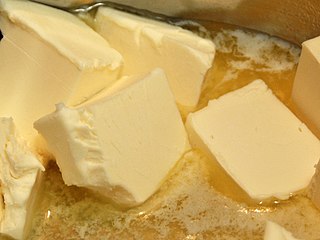
Butter is a dairy product made from the fat and protein components of churned cream. It is a semi-solid emulsion at room temperature, consisting of approximately 80% butterfat. It is used at room temperature as a spread, melted as a condiment, and used as a fat in baking, sauce-making, pan frying, and other cooking procedures.
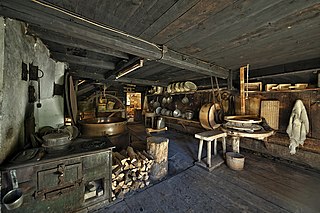
A dairy is a place where milk is stored and where butter, cheese and other dairy products are made, or a place where those products are sold. It may be a room, a building or a larger establishment. In the United States, the word may also describe a dairy farm or the part of a mixed farm dedicated to milk for human consumption, whether from cows, buffaloes, goats, sheep, horses or camels.
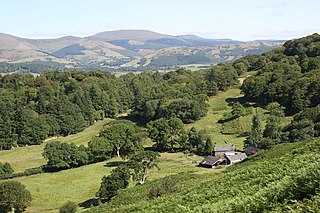
Ceredigion, historically Cardiganshire, is a county in the west of Wales. It borders Gwynedd across the Dyfi estuary to the north, Powys to the east, Carmarthenshire and Pembrokeshire to the south, and the Irish Sea to the west. Aberystwyth is the largest settlement and, together with Aberaeron, is an administrative centre of Ceredigion County Council.

Curd is obtained by coagulating milk in a sequential process called curdling. It can be a final dairy product or the first stage in cheesemaking. The coagulation can be caused by adding rennet, a culture, or any edible acidic substance such as lemon juice or vinegar, and then allowing it to coagulate. The increased acidity causes the milk proteins (casein) to tangle into solid masses, or curds. Milk that has been left to sour will also naturally produce curds, and sour milk cheeses are produced this way.

Buttermilk is a fermented dairy drink. Traditionally, it was the liquid left behind after churning butter out of cultured cream. As most modern butter in western countries is not made with cultured cream but uncultured sweet cream, most modern buttermilk in western countries is cultured separately. It is common in warm climates where unrefrigerated milk sours quickly.
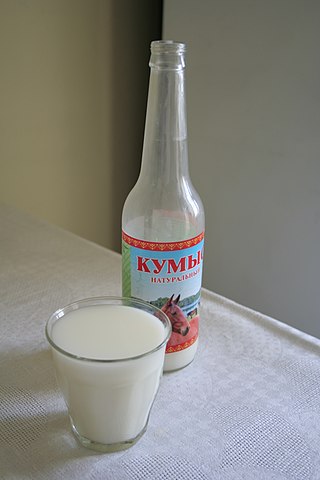
Kumis is a fermented dairy product traditionally made from mare milk or donkey milk. The drink remains important to the peoples of the Central Asian steppes, of Turkic and Mongol origin: Kazakhs, Bashkirs, Kalmyks, Kyrgyz, Mongols, and Yakuts. Kumis was historically consumed by the Khitans, Jurchens, Hungarians, and Han Chinese of North China as well.

The Oregon Bottle Bill is a container-deposit legislation enacted in the U.S. state of Oregon in 1971 that went into effect in October 1972. It was the first such legislation in the United States. It was amended in 2007 and 2011. It requires applicable beverages in applicable sizes in glass, plastic or metal cans or bottles sold in Oregon to be returnable with a minimum refund value. The refund value was initially 5 cents until April 1, 2017, when it increased to 10 cents. The Oregon Legislature has given the Oregon Liquor Control Commission the authority to administer and enforce the Bottle Bill. Oregon Beverage Recycling Cooperative (OBRC), a private cooperative owned by retailers and beverage distributors, administers the collection and transportation of returned containers and keeps all the unclaimed deposits. Materials from returned containers are sold by the OBRC and proceeds are handed out to beverage distributors. In 2022, the bottle bill was expanded to include canned wine, which will become eligible for redemption on July 1, 2025.

Milk delivery is a delivery service dedicated to supplying milk, typically in bottles or cartons, to customers' homes. This service is performed by a milkman, milkwoman, or milk deliverer. The delivery route is a milk route or milk run.

A butter churn is a device used to convert cream into butter. This is done through a mechanical process, frequently via a pole inserted through the lid of the churn, or via a crank used to turn a rotating device inside the churn.
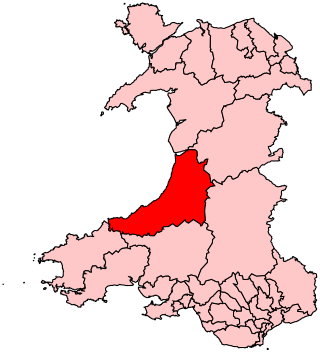
Ceredigion is a parliamentary constituency represented in the House of Commons of the UK Parliament. Created in 1536, the franchise expanded in the late 19th century and on the enfranchisement of women. Its boundaries remained virtually unchanged until 1983. From 1536 until 1885 the area had two seats : a county constituency (Cardiganshire) comprising the rural areas, the other the borough constituency known as the Cardigan District of Boroughs comprising a few separate towns; in 1885 the latter was abolished, its towns and electors incorporated into the former, reduced to one MP. The towns which comprised the Boroughs varied slightly over this long period, but primarily consisted of Cardigan, Aberystwyth, Lampeter and Adpar, the latter now a suburb of Newcastle Emlyn across the Teifi, in Carmarthenshire.

Glass milk bottles are glass bottles used for milk. They are generally reusable and returnable - used mainly for doorstep delivery of fresh milk by milkmen. Once customers have finished the milk, empty bottles are expected to be rinsed and left on the doorstep for collection, or rinsed bottles may be returned to a participating retail store. Bottle sizes vary depending on region, but common sizes include pint, quart or litre.

Ecton is a hamlet in the Staffordshire Peak District. It is on the Manifold Way, an 8-mile (13 km) walk and cycle path that follows the line of the former Leek and Manifold Valley Light Railway. Population details as at the 2011 census can be found under Ilam.
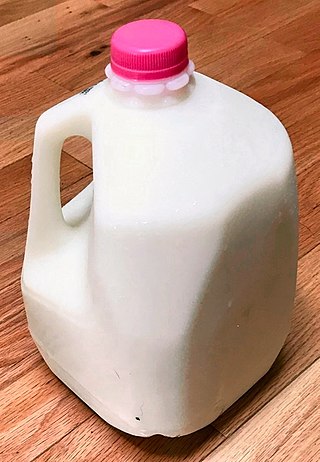
Plastic milk containers are plastic containers for storing, shipping and dispensing milk. Plastic bottles, sometimes called jugs, have largely replaced glass bottles for home consumption. Glass milk bottles have traditionally been reusable while light-weight plastic bottles are designed for single trips and plastic recycling.

The square milk jug is a variant of the one-gallon (3.785-liter) plastic milk container sold in the United States. The design was introduced in the summer of 2008 and is marketed as environmentally friendly because of the shape's advantages for shipping and storage.

There are ten states in the United States with container deposit legislation, popularly called "bottle bills" after the Oregon Bottle Bill, the first such legislation that was passed.
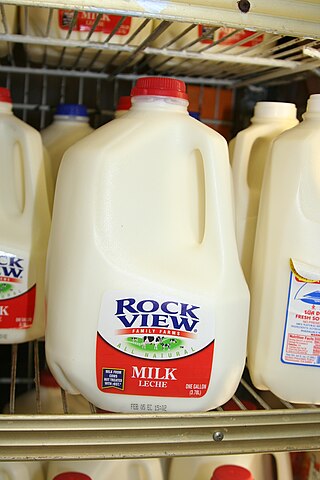
Milk chugging, or the gallon challenge or milk challenge, is the sport of consuming a large amount of milk within a set period of time. Although procedures vary, the general parameters are that a person is given 60 minutes to drink one US gallon of whole milk without vomiting. A gallon milk jug is a common size of milk container in the United States.

The GWR Siphon was a series of enclosed milk churn transport wagons built by the Great Western Railway and continued by British Railways.

Milk tank wagons were a common sight on railways in the United Kingdom from the early 1930s to the late 1960s. Introduced to transport raw milk from remote dairy farms to central creameries, milk trains were the last railway-based system before the move to road transport.

A milk churn stand was a standard-height platform on which milk churns would be placed for collection by cart or lorry. Some were simple and made of wood, but the majority were built from stone or concrete blocks. They were once a common roadside sight in Britain in areas which carried out dairy farming, but collection of milk churns from stands ceased in Britain in 1979. Many have survived, some being renovated to memorialise the practice, while others have been dismantled or left to decay.
{{cite journal}}: Cite journal requires |journal= (help){{cite journal}}: Cite journal requires |journal= (help)